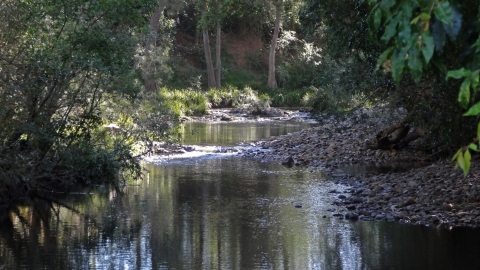- Home
- Assessments
- Bioregional Assessment Program
- Methods
- Surface water modelling
Executive summary
The surface water modelling provides key information for bioregional assessments (BAs), including estimates of the future surface water regime within the subregion or bioregion, and, in particular, those aspects of the regime subject to changes due to coal resource development.
This submethodology summarises the approaches taken in surface water modelling in BAs. It outlines options for modelling, makes recommendations on modelling tools that are fit for purpose, and highlights linkages with other components of the BAs.
Surface water modelling in the BAs is a two-stage process. Firstly, fluxes from the landscape (predominantly surface runoff, interflow and baseflow) are modelled using a streamflow model. These fluxes are then accumulated and routed through the river network using a river system model. It is recommended that, where possible, numerical modelling should use Australian Water Resources Assessment (AWRA) models: AWRA landscape model (AWRA-L) for streamflow modelling and AWRA river model (AWRA-R) for river system modelling. While other models have relatively similar prediction performance, AWRA is readily available and couples readily with the groundwater models used in BAs.
The surface water modelling outputs hydrological response variables, the hydrological characteristics of the system or landscape class that potentially change due to coal resource development. The following are examples of hydrological response variables:
- P01 – the daily streamflow rate at the 1st percentile (ML/day)
- ZFD – the number of zero-flow days per year. Zero streamflow is identified using the minimum detectable flow. For ease of applicability, a threshold of 0.01 ML/day is set for determining the ZFD for all surface water model nodes
- P99 – the daily streamflow rate at the 99th percentile (ML/day)
- FD – High-flow days, the number of days per year with streamflow greater than the 90th percentile from the simulated 90-year period (2013 to 2102)
- AF – the annual flow volume (GL/year)
- IQR – the interquartile range in daily streamflow (ML/day); that is, the difference between the daily streamflow rate at the 75th percentile and at the 25th percentile.
For each of the hydrological response variables, a time series of annual values is constructed.
The surface water model results are used to refine the groundwater models, particularly for surface water ‒ groundwater interactions. The surface water model provides inputs to the boundary conditions of the groundwater model and the groundwater model provides inputs to the surface water model as changes in baseflow generation. The surface water modelling also interacts with the BA process for placing model nodes across the landscape, including on the stream network.
A sensitivity analysis is conducted to identify the parameters that affect the hydrological response variables the most. The uncertainty due to the most important parameters is then quantified.
Results from the surface water modelling are reported in product 2.6.1 (surface water numerical modelling) and in product 2.5 (water balance assessment).
These results are used in subsequent receptor impact modelling and the impact and risk analysis in the BA.

Methodology Download
METHODOLOGY FINALISATION DATE
METHODOLOGY CONTENTS
- 1 Background and context
- 2 Components of surface water modelling
- 3 Streamflow modelling
- 4 River system modelling
- 5 Constituent modelling
- 6 Modelling the impacts of coal resource development
- 7 Linkages with other modelling components
- 8 Outputs from surface water modelling
- Appendix A Modifications to AWRA-R
- Appendix B Proposed structure of product 2.6.1 (surface water numerical modelling) and product 2.5 (water balance assessment)
- References
- Datasets
- Citation
- Acknowledgements
- Contributors to the Technical Programme
- About this submethodology
